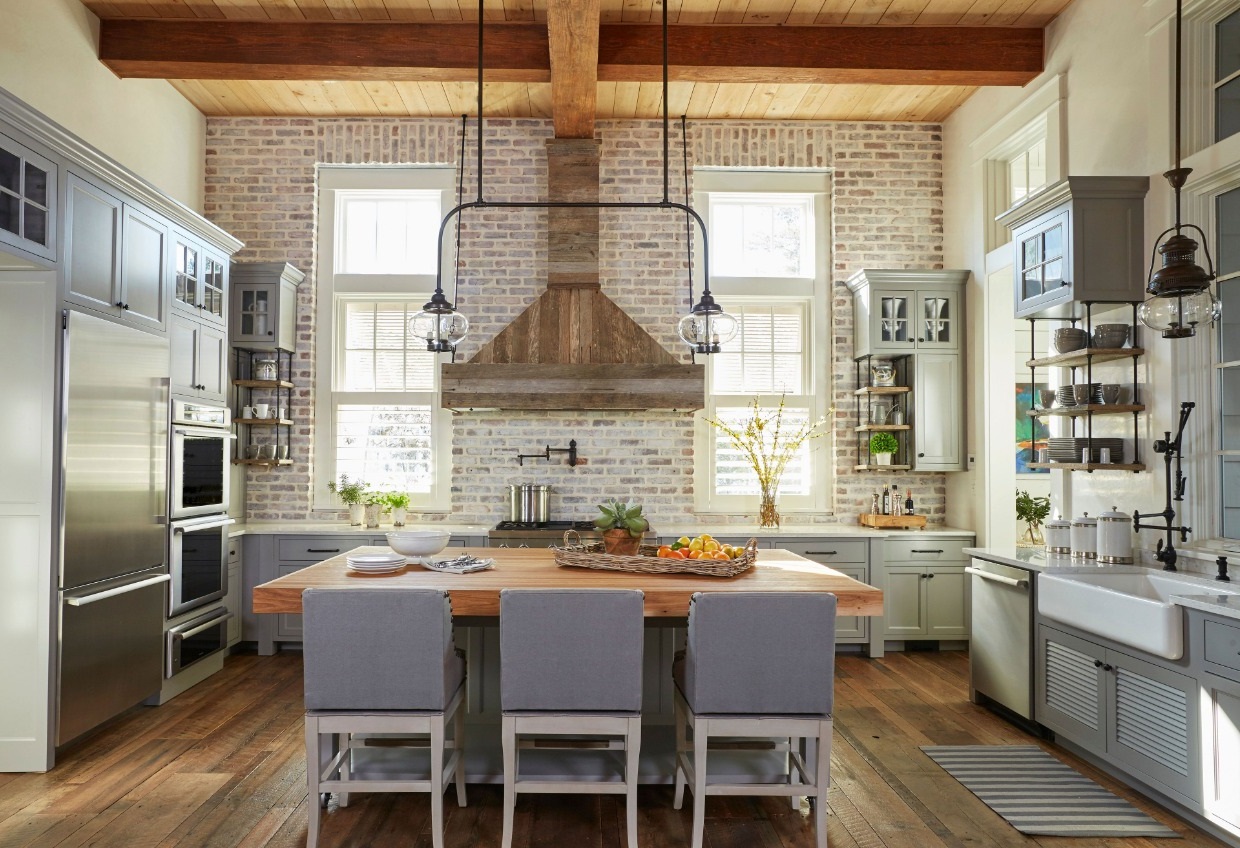An increasingly popular trend is industrial style, which moves towards anything that can be used in a complete kitchen. Vital industrial elements combine with simple accessories and give your kitchen a pleasant charm, enhanced by deliberate quirks and minor blemishes.
That’s why industrial “come in” in the kitchen.
The “industrial style” furnishing trend, which turns your four walls—and now also the kitchen—into a fabulous loft with industrial charm, is becoming increasingly popular. Industrial style, which is often called factory style, gives every kitchen a unique look.
You’re on trend with pure, rustic designs in muted colours such as brown, black, white or grey and materials made from stainless steel, stone, concrete or untreated wood. The modern industrial style has spread to many homes and has grown from a popular trend to a popular interior design style.
Although its application in a large, stylish factory loft is obvious, the industrial style also has an elegant appeal in a mini, single, or open family kitchen.
With the right colors, furniture, and accessories, the kitchen can be transformed into a chic and modern loft. Old items are used in new ways, and ingredients take on new meanings in the kitchen. The industrial style achieved its popularity primarily through the combination of raw surfaces with a cool yet homely atmosphere.
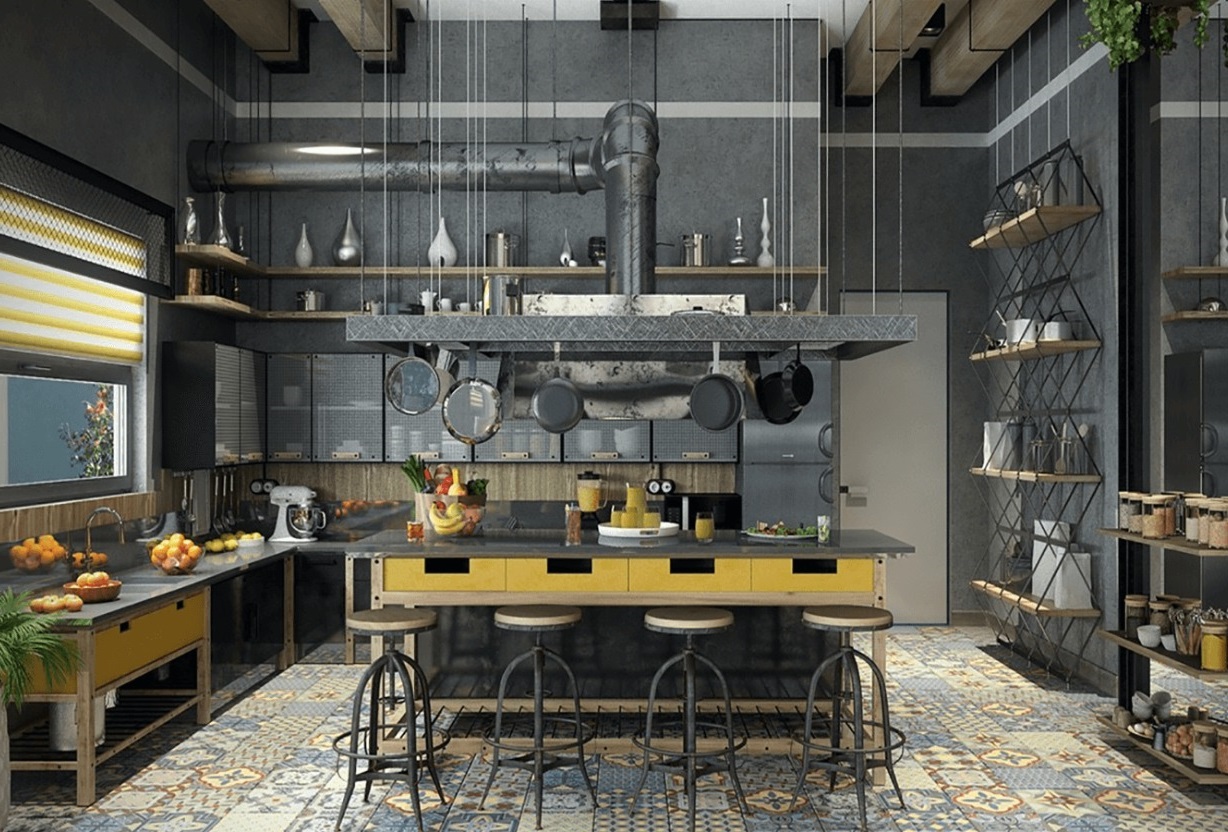
Where does industrial style come from?
Clear, calm, powerful. The first signs of industrial style date back to the 19th century, a time of industrialization when people relied on one thing: practical furniture made from durable, long-lasting materials. Brick walls, metal pipes, retro steel, workbenches, glass blocks, or black steel-structured windows are included. At that time, this had nothing to do with design but functionality; however, that changed in the US and UK from the 1940s onwards.
In particular, the drastic increase in rental prices attracts artists and creative people, especially to old factory buildings, where they not only set up their spacious studios but also design their living spaces with innovative ideas. Of course, it always has a casual industrial charm. This also includes, for example, unplastered walls, exposed pipes or brickwork. Simple interiors are combined with imperfect and fabulous vintage pieces. This laid the foundation for the industrial style.
From the 1980s onwards, this trend became increasingly popular in Europe and is still an indispensable interior design style today. Kitchens, in particular, are increasingly being implemented in an industrial style. While high ceilings and wide open spaces add a finishing touch to the look, you still don’t need a loft in New York. It is important to find the right mix of materials, individually tailored to each room, and avoid too much decoration.
This is what makes the kitchen industrial-style
The industrial style is characterized primarily by its roughness. The factory style has recently established itself as a popular furnishing style, especially as a trend for living rooms. It seems a bit unplanned, and as a result, industrial-style rooms tend to look disorganized, individual, and less like a home catalogue.
Imperfect furniture with obvious signs of wear is combined with warm accessories to create comfort for each guest or your own family. Touches of soft materials, such as curtains or pillows, enhance the rustic charm. Most importantly, pieces of wood and metal objects that had long been considered unusable are reused and reused.
Creative and individual. Industrial style for your kitchen
Timeless comfort, urban style, elegant minimalism. Industrial style has charm and can sometimes look imperfect – almost unfinished. You don’t necessarily need a large and spacious kitchen with a loft character to perfect the look. Even in small rooms and kitchens, industrial charm can be achieved quickly and uncomplicatedly. The reason: Almost no other furnishing style offers a variety of planning options and unique solutions tailored to your individuality as an industrial style. That’s why it equally meets the highest demands in terms of design and functionality.
Using various strong and resistant materials and surface structures, such as grey concrete, paint, rough clinker, smooth metal, glass, and real wood, creates a unique look. A well-thought-out lighting concept, conscious use of small flaws, blemishes, and colour accents through decorative elements also create space for creativity and individuality. This combination gives your kitchen a clean, rustic, yet simple feel that catches the eye.
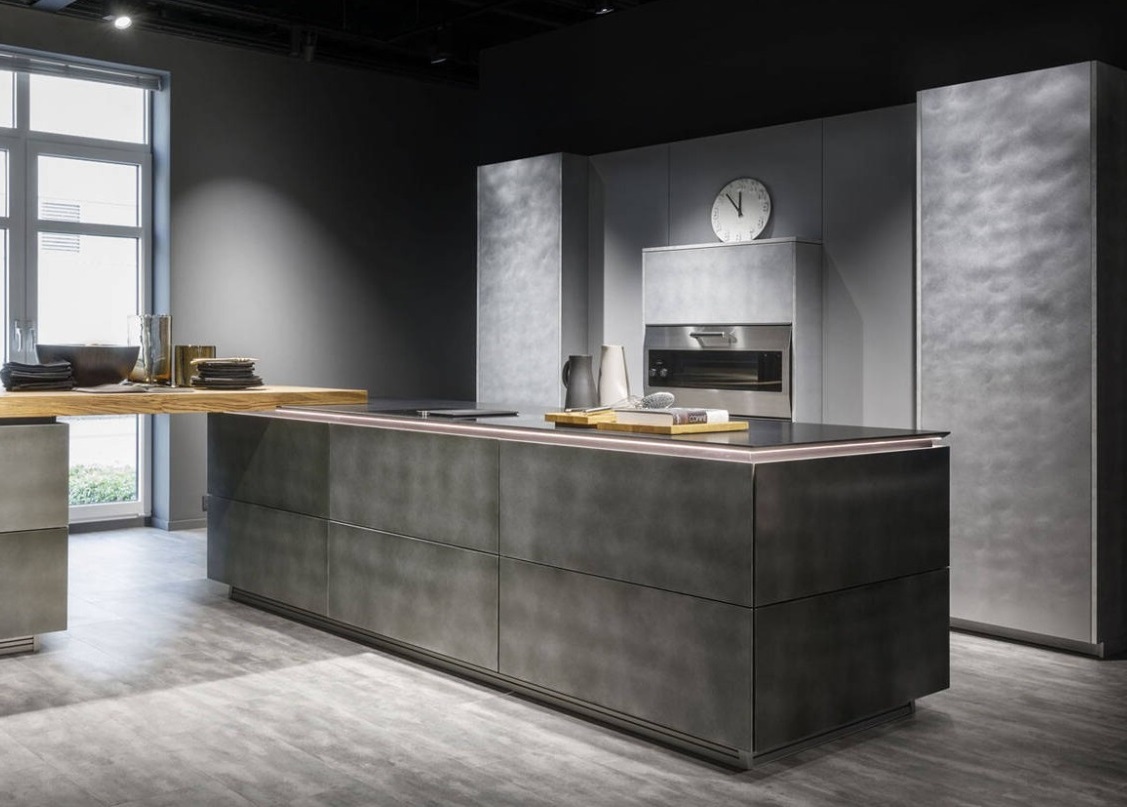
The perfect match: industrial and vintage style
The industrial style complements the vintage trend, which is also increasingly popular. Vintage means furniture or decorative elements with a long-forgotten used look are showcased in homes and kitchens. Many pieces of furniture in the vintage trend have colourful and fun elements, creating the perfect contrast to the kitchen’s evident and industrial solid style.
You can get inspiration for this on the web, for example, on Pinterest, Instagram or eBay. At flea markets, you can often find unique and vintage furniture or accessories made in a vintage style and promise a beautiful secondhand look for your four walls.
What makes industrial style so unique is its diversity and imperfection, which leaves much room for individual and unique living elements. The imperfect beauty is achieved consciously and gives a special touch to industrial-style kitchens.
Create an industrial kitchen look with colours.
In the industrial style, calm colours such as petrol, brown, or dark blue are increasingly used, while black and white are also very important. Gray is also very popular on walls, giving them a rustic feel. Dark floors made of wood, stone, or cork are also popular in industrial styles because they make furniture and accessories look much better.
White elements then lend a certain warmth and comfort to the room, which is especially true in the kitchen. This ensures the room becomes a meeting place for social evenings and cooking sessions. The industrial style creates a calming atmosphere in the room.
However, colours from a colourful palette are also used in the industrial style. This means you can use colour highlights that contrast with black, white, or grey furniture. Small yellow, red or orange elements look very good in the industrial style. To achieve the perfect industrial style, bright colours should be used sparingly to maintain a rustic style, and individual splashes of colour should only be used as eye-catchers.
Wood tones can also achieve a beautiful industrial room effect, for example, by restoring the room’s warmth in contrast to a rough grey floor. The room should maintain an industrial feel, and the colours used should be those expected in any industrial warehouse or workshop.
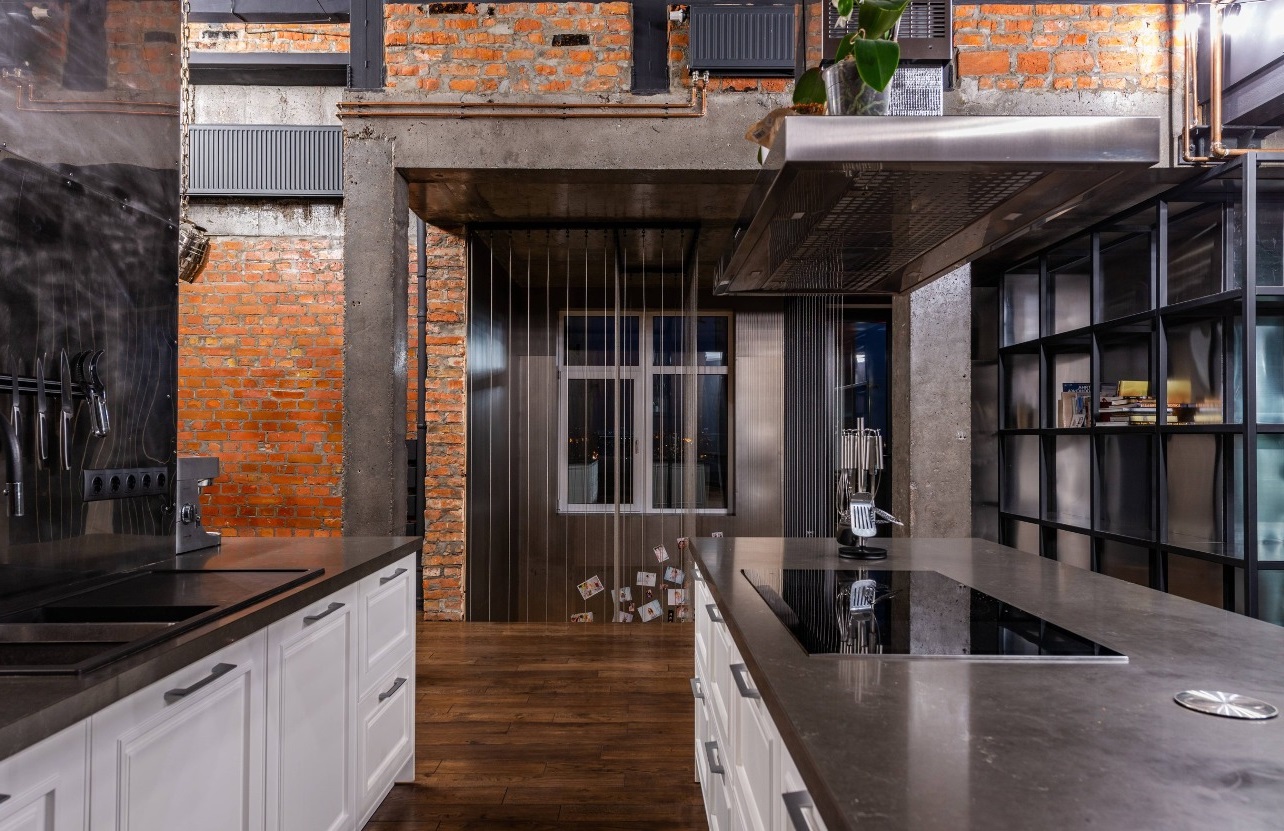
Industrial kitchen look pattern
Patterns are rarely found in the core elements of industrial style, so the highlights can be highlighted with cute accessories, such as a checkered look or a striking circular pattern. It is essential that the raw character of the factory chic style is preserved and that patterns are used precisely and skillfully. The principle applies here: less is more! Most importantly, patterns should be used that reflect ageing furniture, and so only sometimes match the picture.
Well prepared and processed, the materials used are also ideal for your kitchen. Of course, solid concrete kitchens are rarely used, as they can pose structural challenges. That’s why, for example, concrete displays are now being recreated in a realistic-looking way, either through decoration or through wafer-thin layers of concrete bonded to a suitable carrier material.
Colour concept
Different compositions of materials usually result in this: industrial style is dominated by calm colours such as petrol, brown, dark red, dark green, dark blue, black, white or grey – in the kitchen, this applies especially to the fronts, carcasses and islands kitchen. The colour concept is based on a loft known only in New York. It also fits perfectly with the vintage look that is currently popular.
For this cool finish, we recommend a warm, dark wood or cork floor so the design can develop its full effect.
Facility
When talking about industrial style, the motto is: less is more. Here, the focus is on selected elements, shapes, colours and materials that run as a constant line through the spatial concept.
Stylish, but no-nos for an industrial-style kitchen are floral patterns, colourful walls, non-functional decor, or wooden cabinets with glass fronts. However, The colours of accessories and decorative items can be bold. Whether furniture, the kitchen’s back wall, individual cupboards, vases on the shelves or various kitchen utensils, they attract attention and add charm to the rustic look of industrial style. Everything can shine in red, orange or yellow, for example. However, you can give a brighter impression to your modern kitchen with warm pastel colours such as mint, pink, or light blue.
Elements with a rusty look also emphasize intentional imperfections in your kitchen. Copper and brass accents also support the cool and rough industrial look but, at the same time, provide shine and elegance to the kitchen. If you don’t want a kitchen without handles, you can use fake handles made of dark metal or rough knob handles.
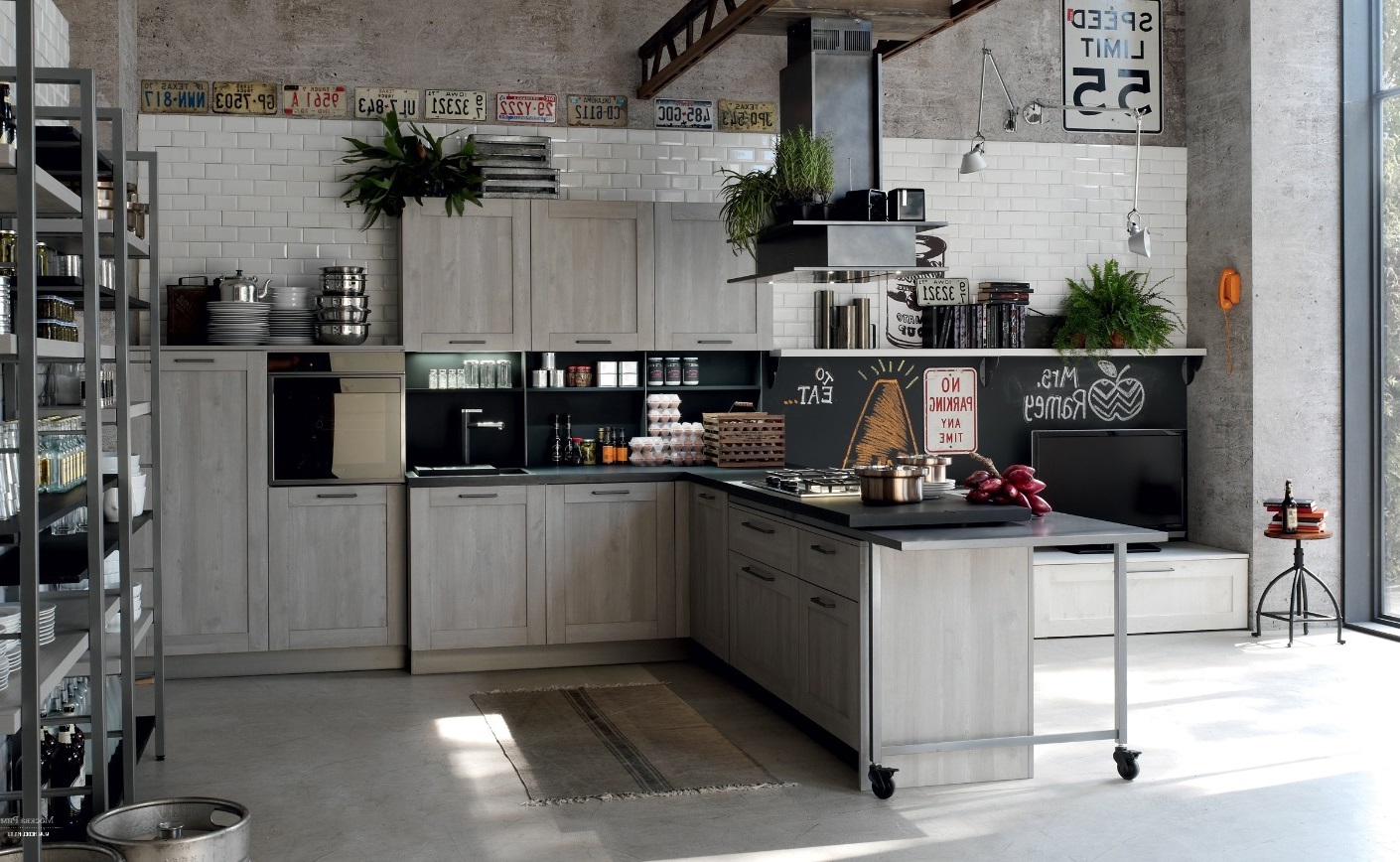
Industrial-style materials and surfaces
The dominant industrial style uses materials that are considered strong, hard, and also a bit cool because functionality is the main focus. Metal, steel, or stainless steel is the main component of an industrial-style kitchen. In the form of pipes, shelves, or lamps, metal creates harmonious accents. Rusty elements can also be used, as they provide just the right amount of imperfection to the room.
The combination of different materials is also a characteristic of the industrial style, often called the factory style. The distinctive contrasts that highlight this style’s uniqueness ultimately combine to create a harmonious overall picture. The following applies: Whatever you like is allowed. Elements of wood, concrete, metal, steel, stainless steel, copper, glass, rough leather, or even untreated velvet are all part of the true industrial style.
Sheet metal appears welded or riveted to show how beautiful imperfections can be. Copper and brass are very popular here as the rough and cold materials provide the necessary shine and elegance. Copper or brass-handled cooking pans give an industrial kitchen a unique look. Interestingly, this metal material is straightforward to clean or, if desired, can develop a nice patina.
In addition to cool metals, natural materials such as wood, leather, or fur are best used in an industrial style, such as small rugs or chair cushions. The wood doesn’t have to be perfect. Old boxes or pallets can be turned into seating, and wine crates can be used as wall shelves.
The informality of the industrial style is supported by apparent signs of wear on the wood, as the style can only be implemented perfectly through peeling paint or minor burn marks on the wood. The wood then gives the kitchen the necessary warmth. Leather chairs or bar stools complete the picture. Colours suitable for industrial style, namely black or dark brown, bring comfort to the kitchen.
Stone can also be found in an industrial style. For example, an excellent wine rack can be made from old brick, or brick looks terrific when painted white on the wall. The industrial effect must be noticeable when the brick parts are not plastered.
Stone is also suitable for floors with an industrial look. In grey, accents are made with sheepskin or old Flokati carpet. Parquet or cork flooring materials are also ideal for use in industrial designs. Old floorboards with noticeable scratch marks give the floor a unique charm and make it look warmer.
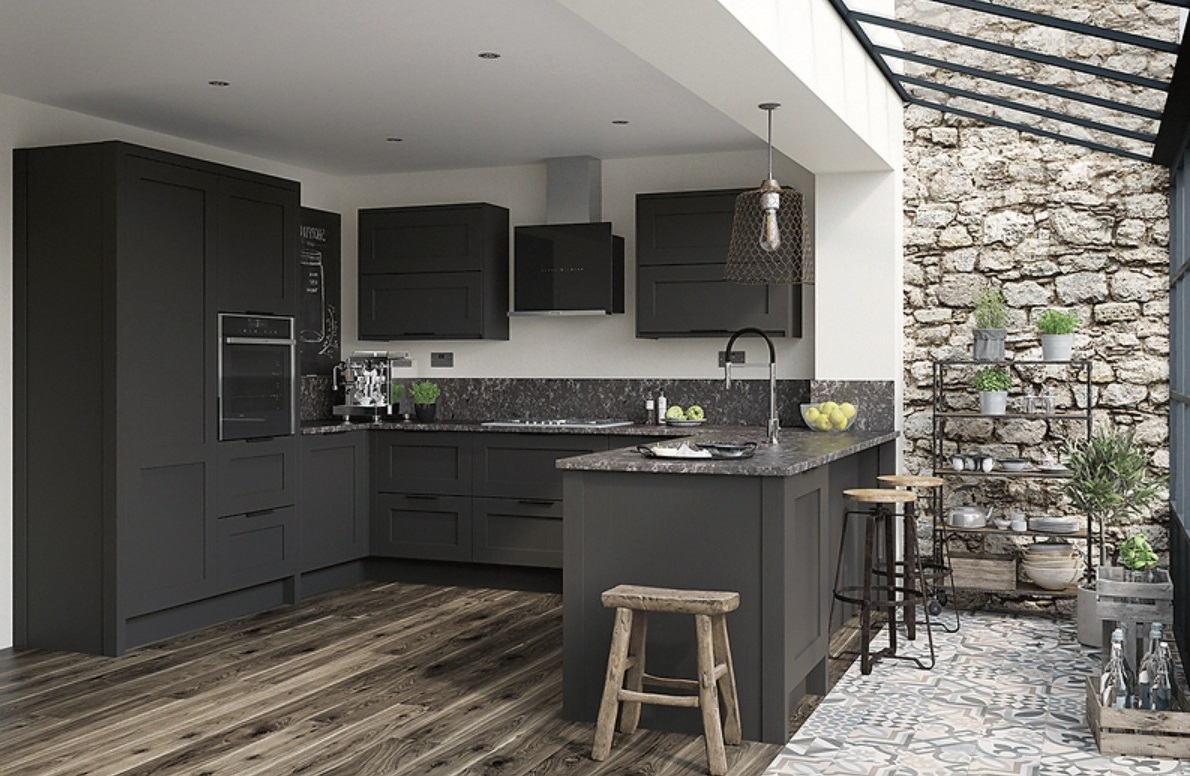
Industrial-style kitchen furniture: This is how to bring the trend to the kitchen
The elegance of the excellent industrial look with its striking style elements is now also applied to kitchen furniture. There are stone-look kitchen fronts for industrial-style kitchen furniture, such as concrete or slate, which look real with the natural relief surface. Stainless steel kitchen fronts and work surfaces are also suitable for kitchen furniture with an industrial look. Wood-look cabinet fronts increasingly feature signs of artificial wear to achieve a rustic appearance. Kitchen fronts with wooden structures and a rough grain or plank appearance are also characteristic here, making the fronts look like they are made of wooden slats.
Stainless steel kitchen tables are also trendy. They appear elegant and of high quality and impress with their best material requirements. Stainless steel worktops are very strong and resistant to dirt, especially with proper care.
Stone and wood decorations are also used for industrial-style work tables. The industrial style looks very authentic with a workbench made of concrete or a concrete look, which is sturdy but stylish. Thick kitchen tables with a thickness of around 8-10 cm are often used to achieve a sturdy and heavy appearance suitable for industrial style. This sturdy-looking worktop is then contrasted with an extra thin work surface made of stainless steel, making the kitchen look more elegant.
Many versions of kitchen handles perfectly emphasize the industrial look. Handles made of dark metal, finished with signs of wear and a forged appearance are characteristic of the appearance of a used kitchen. Rustic knob handles or recessed handles, as we know them from old pharmacy and grocery store cabinets, are a hallmark of modern factory-style kitchen designs.
Steel structures or old visible welded pipes are recommended for open shelves and body or side table support systems. Used wine crates can also be used as open shelving in the upper cabinet area.
Alcove liners with the appearance of old bricks are a great but effective fuel barrier for kitchen alcoves. The combination of materials should always look used and completely imperfect. The kitchen then makes it clear that it is secondhand, that there are people working in it, and that, thanks to the industrial style, you can spend time here comfortably without having to worry about something getting dirty.
The choice of furniture is also essential for a pure industrial style. They underline the utilitarian character and unique charm of the kitchen. If your kitchen offers enough space for a dining area, a functional dining table made of untreated wood and metal elements, a custom industrial lamp or heavy chairs made of wood and leather are perfect. Imperfect details make for an ideal look. Small bumps, cracks, signs of wear, and, in short, minor stains can even appear here and give an individual touch to the straight-lined kitchen.
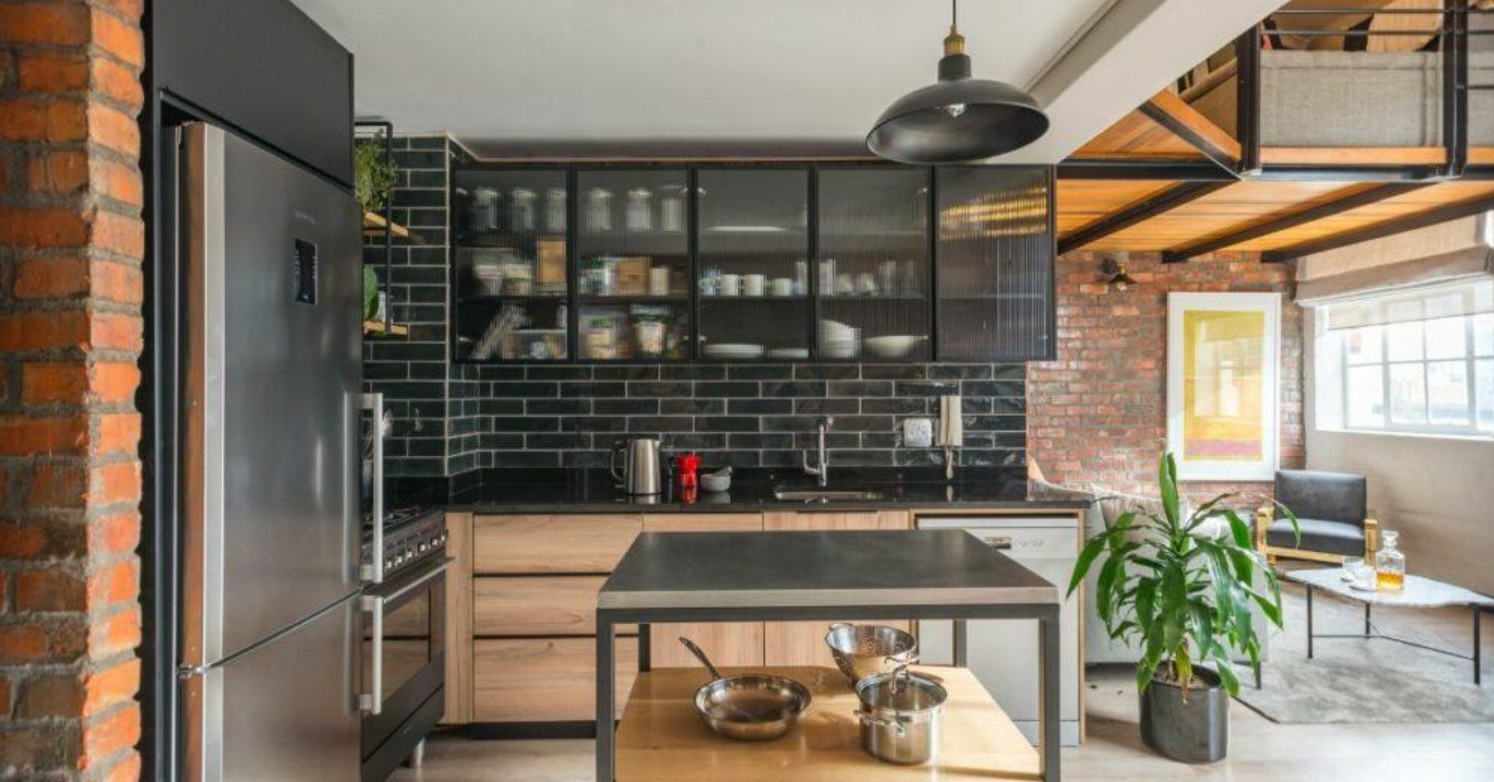
Industrial style decoration
Industrial-style accessories are also chosen to match metal, wood, or leather. Old pipes can be turned into lamps, and with a soft lampshade, they will immediately look very homely. Brown or black leather sofas should not be missing, especially in the kitchen and living room. A small wooden bench that can be used as a seat or side table completes the overall picture.
Old metal or raffia baskets can also store cookbooks and recipes. Ordinary industrial lamps or light bulbs without a lampshade but with visible wires can be hung above the dining table. Candles are also often used in industrial styles to create a warm light when eating or cooking.
In industrial style, only a few decorative elements are generally needed to create the right charm. Here, too, you can get great inspiration while browsing the flea market. The absolute decorative highlight is the chalkboard-painted walls, which look functional yet bring great elegance and modernity to the room. A small herb garden made from old clay pots or metal boxes with a worn look is also a perfect accessory in industrial style, as green plants perfectly complement the cool, muted colours.
The diversity of industrial style can be seen from the wide choice of materials, colours, and decorations. Ideas are almost limitless, and they can be developed individually for your own kitchen with the kitchen experts at the kitchen studio to create a unique industrial style. A fully equipped kitchen, in particular, can better express your personality. The individual touches show how much love industrial style can create in the kitchen.
Do you also want to bring a rustic industrial charm to your kitchen and thus make an accurate statement?
Industrial style offers a variety of options for designing your personal dream kitchen. The best way to choose suitable materials, colours, and elements adapted to your spatial conditions and plan the kitchen optimally is to ask for advice from a kitchen expert.
Unleashing the Charm of Industrial Look Kitchen Cabinets: A Perfect Blend of Modernity and Elegance
Explore the realm of industrial-style kitchen cabinets and uncover a seamless fusion of contemporary design and sophistication. These cabinets not only serve a practical purpose but also impart a dash of allure to your kitchen area. Featuring clean lines, exposed materials, and a minimalist aesthetic, they introduce a distinctive industrial ambiance that complements various decor styles. Incorporating the keywords “industrial-style kitchen cabinets” in this opening helps enhance the article’s SEO value, making it more visible to readers seeking information on this subject. By integrating these keywords organically and without excessive use, the introduction strikes a balance between relevance and readability. The article will delve into the essential attributes of industrial-style kitchen cabinets, including the use of materials such as metal and reclaimed wood, their adaptability to different kitchen designs, and how they can be personalized to suit individual preferences. Whether you lean towards a modern, rustic, or eclectic style, industrial-style kitchen cabinets can be tailored to align with your requirements. Prepare to revamp your kitchen into a chic and refined space with the timeless allure of industrial-style kitchen cabinets. Let’s delve in and explore the boundless possibilities that lie ahead!
Characteristics of industrial-style kitchen cabinets
Industrial Cabinet Design is an interior design concept that incorporates elements from professional kitchens into a living space. This design style is recognized for its functional features, robust materials, and raw, natural aesthetic. It emphasizes the beauty of unfinished materials, simplicity, and practicality. It is a trend that has captured the attention of homeowners and interior designers alike, distinguished by its ability to blend efficiency with style.
What are industrial-style kitchen cabinets?
Industrial-style kitchen cabinets are defined by the use of raw materials such as metal and wood, minimalist design, and functionality. These kitchen cabinets often integrate both open and closed storage, metal embellishments, and a neutral color scheme.
When referring to industrial kitchen cabinets, we are speaking about furniture that reflects the raw, natural beauty of industrial spaces. These cabinets may combine wood and metal and frequently feature a combination of open shelving and closed storage. Open shelving is ideal for showcasing your exquisite kitchenware or recipe books, adding a personal touch to the room.
Industrial cabinets serve a purpose beyond mere storage. They are an integral part of the visual appeal of a room. Typically characterized by the use of metal, wood, and glass, these cabinets are designed to be robust. They evoke memories of the commercial kitchens and warehouses of the past.
Materials: The selection of materials for industrial cabinets is pivotal. Metals such as iron and steel are popular due to their durability, creating an authentic industrial ambiance. Wood, particularly reclaimed or weathered wood, introduces warmth and a hint of rustic charm, striking the perfect balance.
Design Details: Industrial-style cabinets often showcase minimalist designs. However, it is the small details that infuse character. Exposed screws, metal handles, and matte finishes are not only functional but also contribute to the overall aesthetic.
Benefits of choosing industrial-style kitchen cabinets
Industrial-style kitchen cabinets offer numerous advantages, including:
Durability: Industrial cabinets are crafted for functionality and durability, enhancing the aesthetic appeal of your kitchen.
Easy maintenance: Industrial kitchens are easy to maintain and clean.
Energy efficiency: Industrial kitchens are designed to be energy-efficient, potentially reducing energy costs.
Safety: Industrial kitchens are designed with safety considerations in mind.
Flexibility: Industrial kitchens can be customized to suit various budgets and accommodate a range of preferences.
Versatility: Industrial kitchens can seamlessly integrate into spaces of all sizes.
Social space: Industrial kitchens can serve as a social focal point for the home, ideal for families looking to cook, work, entertain, and spend time together.
How to integrate kitchen cabinets with an industrial look into your kitchen design
To achieve an industrial look with your kitchen cabinets, you can consider:
Colors: Stick to neutral tones such as grays, whites, and matte blacks. You can also introduce dark greens and blues for warmth and depth.
Industrial-style kitchens typically feature a dark, neutral base color palette, including grays, whites, and matte blacks. These neutral colors serve as a backdrop for standout pieces and contribute to the industrial look and ambiance. Pair black stone countertops with exposed brick, and add a few striking wood accents. Complete the look with bright brass faucets and doorknobs, and consider incorporating a pop of color with a bright green indoor garden or antique yellow stools.
Cabinet styles: Opt for Shaker-style cabinets for a traditional look, or modern cabinets for a sleek appearance. For a unique look, choose modern, sleek cabinets. Glossy cabinets complement natural wood or brick, and white or black cabinets offer a simple style. Select handleless doors, or go for sleek metal handles for a clean and timeless look — you can even unify the room by choosing the same metal for your handles and faucets.
Handles: Choose handleless doors or sleek metal handles. You can also coordinate the metal finishes of your handles and faucets.
Materials: Utilize various materials, including wood, metal, glass, stone, brick, concrete, laminate, ceramic tile, and more. The choice of material for industrial cabinets is crucial. Metals like iron and steel are popular for their durability and ability to create an authentic industrial ambiance. Wood, especially reclaimed or recycled wood, adds warmth and a hint of rustic charm, striking a perfect balance.
Lighting: Incorporate pendant lights with a metal finish or Edison bulbs. Industrial kitchen lighting provides a great finishing touch to your space and offers a personal touch to your kitchen.
Pendant lights are a great addition to industrial-style kitchens and can be used to delineate different areas of your kitchen. There are numerous styles of industrial pendant lights for kitchens available, so you can select one that suits your aesthetic. Metallic finishes and wire elements are well-suited for industrial spaces, while white and glass can introduce brightness to darker color schemes.
If pendant lights don’t appeal to you, consider a statement ceiling light. Exposed, explosive lighting elements are a natural fit for the industrial trend, and task lights can enhance visibility for activities like food preparation and cooking.
Accessories: Incorporate vintage or industrial-themed furniture, such as old factory equipment or metal containers.
Open shelving: Use open shelving to create a spacious and airy feel. Open shelving is a classic feature of industrial-style kitchens and is a practical space-saving solution for smaller kitchens. Combine upper cabinets with open shelving to craft a striking feature wall.
You can use open shelving to showcase your favorite dishware and cookware or to display your most attractive bottles and jars as a design element. Opt for the same material as your cabinets for a cohesive look, or consider contrasting materials like metal and wood designs to break up your cabinets.
Bold accents: Introduce vibrant artwork or colorful appliances as bold accents. Reclaimed wood: Incorporate reclaimed wood beams to establish a warm and welcoming ambiance.
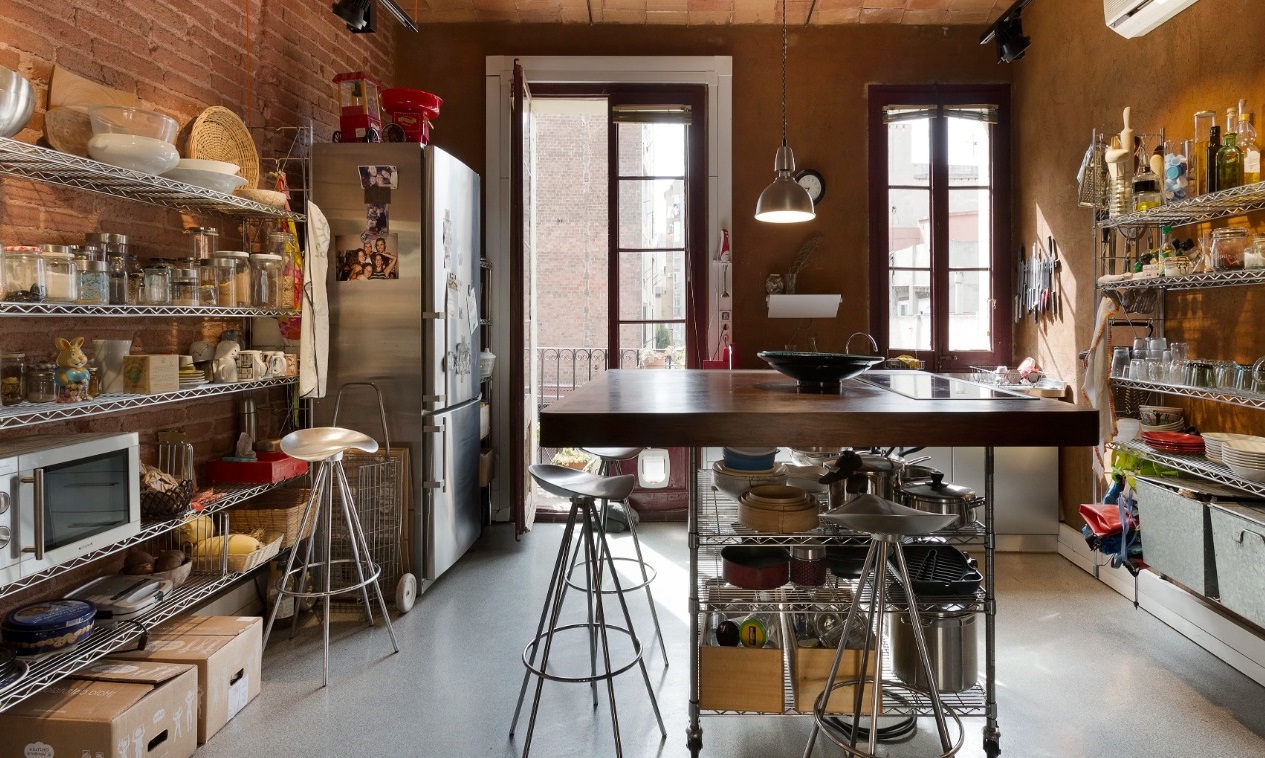
Maintenance and upkeep for kitchen cabinets with an industrial look
Even though industrial kitchens are recognized for their sturdiness and practicality, it is crucial to properly maintain them to ensure their durability. Here are some tips for maintaining your industrial kitchen to keep it looking and working at its best:
Regularly clean stainless steel surfaces with warm water and a mild detergent to prevent smudges and fingerprints, avoiding abrasive cleaners and scrub brushes that can cause scratches.
Apply a sealant to concrete countertops to protect them from stains and spills, following the manufacturer’s instructions for the appropriate sealer and reapplying as necessary.
Use a soft cloth or brush to wipe down exposed brick and remove dust and dirt, avoiding harsh chemicals or abrasive cleaners that can harm the brick surface.
Regularly check and clean your ventilation system to maintain proper airflow and prevent the accumulation of grease and odors.
Keep an eye on your plumbing fixtures and promptly address any leaks or problems to prevent water damage and preserve the integrity of your industrial kitchen.
By following these maintenance tips, you can ensure that your industrial kitchen remains in top condition and continues to impress both visually and functionally.
Cost considerations for kitchen cabinets with an industrial look
Are you ready to update your kitchen but not quite ready for a complete renovation? Replacing old kitchen cabinets is a great way to rejuvenate an outdated kitchen. Kitchen cabinets often play an underappreciated role in the kitchen. They hold dishes, pots, pans, utensils, food, and snacks on a daily basis, and even endure the occasional slamming of cabinet doors. Most importantly, they draw attention—for better or worse—when someone enters your kitchen. When your kitchen cabinets are damaged or you are ready to update them for a more modern or timeless appearance, it is time to research kitchen cabinet costs.
Factors in Calculating Kitchen Cabinet Costs
Although installing new kitchen cabinets may seem straightforward, several crucial factors must be considered when selecting the right cabinets. Homeowners should assess their existing cabinets to identify any areas needing more space or a different configuration. This evaluation will help determine whether standard or custom cabinets are necessary. Additionally, decisions must be made regarding materials, design, size, color, and finish, all of which come with associated costs. Finally, consider labor and installation costs based on the type of cabinets selected for installation. These factors will help guide your decision-making process as you budget for kitchen cabinets.
Stock Kitchen Cabinets vs. Custom Kitchen Cabinets
Standard kitchen cabinets are the go-to choice for homeowners seeking affordable kitchen cabinets that will still enhance the overall look of their kitchen. The average installation cost for standard kitchen cabinets ranges from $100 to $300 per linear foot. However, homeowners can also opt for custom kitchen cabinets. These kitchen cabinets are completely tailored in terms of size, materials, and design, which is beneficial for unique or oddly shaped kitchens. As expected, custom kitchen cabinets are considerably more expensive than most standard kitchen cabinet options, with costs reaching up to $1,200 per linear foot, including installation.
Materials
The type of material chosen significantly impacts the cost of kitchen cabinets. There are five types of materials available: veneer ($2,000 to $15,000), laminate ($4,000 to $15,000), wood ($5,000 to $25,000), acrylic ($5,000 to $20,000), and stainless steel ($25,000 to $38,000). Most wood cabinets available are not solid wood; they often consist of plywood and solid wood since plywood tends to be more durable and less prone to warping in humid environments.
Design
The design of the kitchen cabinet system contributes to the overall cost. Kitchen cabinets come in framed or frameless styles. Framed cabinets, the traditional option, leave the rails and frame exposed with a flat front frame for mounting the doors. Typically, these cabinets cost between $5,000 and $20,000 or more. Frameless cabinets, European or contemporary styles with no visible rails, are usually more customized and have a heavier box for hanging the doors without a front frame. Frameless cabinets are typically more expensive than framed cabinets, ranging from $6,000 to $30,000 or more.
Conclusion: The enduring charm of industrial-style kitchen cabinets
Industrial-style cabinets have withstood the test of time, remaining popular due to their timeless and classic design. The simplicity and timeless visual appeal of industrial-style cabinet doors have adorned interiors for many years, ensuring that they will continue to be stylish and relevant for a long time.
As previously mentioned, one of the most notable features of industrial-style cabinets is their versatility. They can easily complement any design style, whether it’s traditional, contemporary, or minimalist. Regardless of the overall theme of your home, these cabinets can seamlessly blend in while maintaining their classic allure.
This adaptability is a significant advantage, especially for homeowners seeking a timeless look that can endure ever-changing trends. If you prefer a design that transcends fleeting trends and retains an elegant appeal, industrial-style cabinets are the ideal choice for you.
Even if you have no immediate plans to redecorate, you can be confident that your kitchen will maintain its stylish and sophisticated essence with these timeless cabinets.
